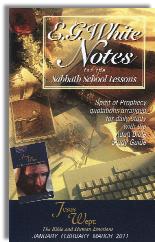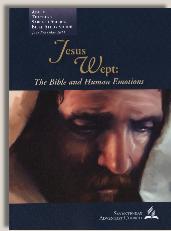|
||||||||||||||
Commentary on "Emotions"
Day 4: Tuesday, December 28, 2010 - Jesus' Emotional Manifestations: Part 1
Overview
Today’s lesson attempts to identify Christ’s emotions, especially His compassion, and how they motivated Him to treat people. It ends by asking us how we express compassion and challenges us to better reveal the compassion that we feel by expressing it in words and deeds.
Observations
The lesson begins with the feeding of the four thousand in the region of the Decapolis on the Galilee. In Mark 8:2 Jesus says,
I have compassion on the crowd, because they have been with me now three days and have nothing to eat.
The lesson then makes the point that, out of His compassion, Jesus miraculously fed them because they were hungry, and no one else had thought of their needs. In context, this story is much more than a story about providing for a crowd’s physical hunger.
The Decapolis, while in Judea, was an area that was heavily populated by Gentiles. This crowd, in contrast with the feeding of the 5,000, was almost certainly heavily Gentile. The disciples had already watched and helped as Jesus provided for the 5,000 Jews at the earlier miracle (Mark 6:30-44); this time, Jesus did something unprecedented. He fed Gentiles, and He had his disciples distribute the food to give Gentiles something to eat.
According to the Torah, no Jew was to share food with Gentiles, yet Jesus was not only providing food for Gentiles but also asking His disciples to feed them. They were breaking bread and feeding Gentiles. Jesus was thus preparing his disciples for their work after His resurrection and ascension—but they could not know this fact in advance. Before His death, therefore, Jesus was already introducing His appointed apostles to the fact that the Living Bread, the Bread of Life—Himself—was not only for Jews but also for Gentiles. Moreover, He was training them to realize that they would be His appointed ones sent to teach the Gentiles the truth about Jesus, to offer them the Bread of Life, to open the doors of the kingdom to believing Gentiles.
Jesus’ compassion on the crowd was iconoclastic to His disciples. He broke Jewish law to serve Gentiles hungry for the words He spoke—so hungry for truth, in fact, that they were willing to suffer physical hunger rather than to miss any words He spoke. He demonstrated that He Himself is the Source of Living Bread, and His disciples were the ones He chose to serve this bread to the nations.
The lesson further refers to Mark 1:40,41, and Mark 6:34. It makes the point that Jesus acted with compassion toward the leper who desired to be healed, and healed him. In fact, the story of the leper is not primarily an example of pity or compassion. Rather, Jesus deliberately broke a ritual law that commanded that no Jew touch a leper without going through a lengthy process of ritual cleansing.
Jesus, however, reached out and touched the leper—and there is no indication that He ritually cleansed Himself. This healing was a sign of His identity as the Messiah. The prophets had foretold that the Messiah would heal the sick, and Jesus boldly fulfilled these prophecies by cleansing the incurable leper. Instead of cleansing Himself after touching the leper, Jesus cleansed the leper himself. There was no need for ritual cleansing—and only the Messiah could do such a thing.
Only the Messiah could fulfill the ritual laws of cleanliness and uncleanliness by cleansing the unclean thing itself. Jesus fulfilled ritual law. Only He could be the Messiah.
The lesson again refers to Christ’s compassion when he held children (Mark 9:36), but again, this passage is not primarily about compassion. In this passage, Jesus holds a child and uses him as an example of the trust and belief in Him that is necessary for a person to receive God Himself.
Finally, the lesson ends with a reference to Mark 10:21, 22:
And Jesus, looking at him, loved him, and said to him, “You lack one thing: go, sell all that you have and give to the poor, and you will have treasure in heaven; and come, follow me.” Disheartened by the saying, he went away sorrowful, for he had great possessions. (ESV)
Again, this passage is removed from its context. In the context, the young ruler asks Jesus what he must do to inherit eternal life. Jesus answers by first identifying Himself with God: “Why do you call me good? No one is good except God alone.”
Jesus does not defer the title “good”. Rather, He accepts it and attributes “goodness” to God alone.
Next Jesus says to the man, “You know the commandments…”to which the man responds, “…all these I have kept from my youth.”
Now Jesus looks at him and loves him and points out that commandment keeping is not enough to get him into heaven. Even if one keeps the commandments perfectly all one’s life, that will not gain him heaven. Jesus now delivers the bottom line: he must be willing to give up what he loves the most in favor of having Jesus.
This story has been misused by Adventists to teach the necessity of keeping the commandments in order to get to heaven. In fact, this story is teaching quite the opposite: commandment-keeping will not assist a person in getting to heaven. Only giving up all one is and loves the most and following Jesus, trusting Him to give him a new identity—only this sort of personal trust and surrender can result in eternal life, because eternal life has nothing at all to do with keeping commandments or doing good. It depends entirely upon believing in the Lord Jesus and being born again of the Holy Spirit.
God is spirit, and those who worship him must worship in spirit and truth.” (John 4:24 ESV)
Jesus answered him, “Truly, truly, I say to you, unless one is born again he cannot see the kingdom of God.” Nicodemus said to him, “How can a man be born when he is old? Can he enter a second time into his mother's womb and be born?” Jesus answered, “Truly, truly, I say to you, unless one is born of water and the Spirit, he cannot enter the kingdom of God. That which is born of the flesh is flesh, and that which is born of the Spirit is spirit. (John 3:3-6 ESV)
Conclusion
- Jesus’ emotions are not the point of His miracles and teachings.
- Jesus did not win people to Himself by warm emotions. His emotions showed, but the point of His miracles and teachings was to demonstrate who He was.
- Jesus challenged people’s beliefs and deeply-held religious practices. He revealed that He Himself was the Source of life, sustenance, and identity. His emotions were incidental to the point of His ministry: He came as the world’s Savior, and only trusting in Him would yield cleansing, provision, and eternal life.
Copyright 2010 BibleStudiesForAdventists.com. All rights reserved. Revised December 27, 2010. This website is published by Life Assurance Ministries, Glendale, Arizona, USA, the publisher of Proclamation! Magazine. Contact email: BibleStudiesForAdventists@gmail.com.
The Sabbath School Bible Study Guide and the corresponding E.G. White Notes are published by Pacific Press Publishing Association, which is owned and operated by the Seventh-day Adventist church. The current quarter's editions are pictured above.
Official Adventist Resources
Standard Edition Study Guide Week 1
Teacher's Edition Study Guide Week 1
Easy Reading Edition Study Guide Wk 1
Search the Complete Published Ellen G. White Writings


